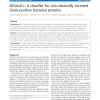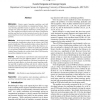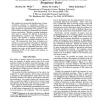20 search results - page 2 / 4 » Use of machine learning algorithms to classify binary protei... |
BMCBI
2011
13 years 12 days ago
2011
Background: Most predictive methods currently available for the identification of protein secretion mechanisms have focused on classically secreted proteins. In fact, only two met...
ICML
2005
IEEE
14 years 6 months ago
2005
IEEE
We develop a novel multi-class classification method based on output codes for the problem of classifying a sequence of amino acids into one of many known protein structural class...
BMCBI
2007
13 years 5 months ago
2007
Background: Odorant binding proteins (OBPs) are believed to shuttle odorants from the environment to the underlying odorant receptors, for which they could potentially serve as od...
BMCBI
2006
13 years 5 months ago
2006
Motivation Protein remote homology prediction and fold recognition are central problems in computational biology. Supervised learning algorithms based on support vector machines a...
ISMB
1993
13 years 6 months ago
1993
Weconsider tile automatedidentification of transmembrane domains in membrane protein sequences. 324 proteins (containing 1585 segrrmnts) werc examined, representing every protein ...



